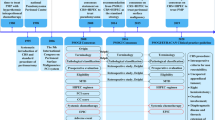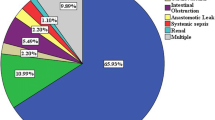Abstract
Background
The efficacy of cytoreductive surgery (CRS) combined with perioperative intraperitoneal chemotherapy (PIC) for patients with pseudomyxoma peritonei (PMP) remains to be established.
Methods
Searches for all relevant studies prior to March 2006 were performed on six databases. Two reviewers independently appraised each study using a predetermined protocol. The quality of each study was assessed. Clinical effectiveness was synthesized through a narrative review with full tabulation of results of all included studies.
Results
Ten most recent updates from each institution were included for appraisal and data extraction. There were no randomized controlled trials or comparative studies. All included articles were observational studies without control groups. Five studies were relatively large series (n≥100). Two studies had relatively long-term follow-up (48 months and 52 months). The median follow-up in the remaining eight studies was shorter than 3 years (range 19–35 months). The median survival ranged from 51 to 156 months. The 1-, 2-, 3- and 5-year survival rates varied from 80 to 100%, 76 to 96%, 59 to 96% and 52 to 96%, respectively. The overall morbidity rate varied from 33 to 56%. The overall mortality rates ranged from 0 to 18%.
Conclusions
This study reviewed current evidence on CRS and PIC for PMP. Only observational studies were available for evaluation, which demonstrated some promising long-term results, as compared to historical controls. Due to the rarity of this disease, a well-designed prospective multi-institutional study would be meaningful.
Similar content being viewed by others
References
Sugarbaker PH. New standard of care for appendiceal epithelial neoplasms and pseudomyxoma peritonei syndrome. Lancet Oncol 2006;7:69–76
Brendan MJ, Cecil TD. The etiology, clinical presentation and management of pseudomyxoma peritonei. Surg Oncol Clin N Am 2003;12:585–603
Carmignani P, Sugarbaker TA, Bromley CM, Sugarbaker PH. Intraperitoneal cancer dissemination: mechanisms of the patterns of spread. Cancer Metastasis Rev 2003;22:465–72
Gough DB, Donohue JH, Schutt AJ, et al. Pseudomyxoma peritonei. Long-term patient survival with an aggressive regional approach. Ann Surg 1994;219:112–9
Miner TJ, Shia J, Jaques DP, et al. Long-term survival following treatment of pseudomyxoma peritonei: an analysis of surgical therapy. Ann Surg 2005;241:300–8
Misdraji J, Yantiss RK, Graeme-Cook FM, et al. Appendiceal mucinous Neoplasms: A Clinicopathologic analysis of 107 cases. Am J Surg Pathol 2003;27:1089–103
Sugarbaker PH. Peritonectomy procedures. Ann Surg 1995;221:29–42
Sugarbaker PH, Graves T, DeBruijn EA, et al. Rationale for early postoperative intraperitoneal chemotherapy (EPIC) in patients with advanced gastrointestinal cancer. Cancer Res 1990;50:5790–4
Katz M, Barone R. The rationale of perioperative intraperitoneal chemotherapy in the treatment of peritoneal surface malignancies. Surg Oncol Clin N Am 2003;12:673–88
Bryant J, Clegg AJ, Sidhu MK, et al. Systematic review of the Sugarbaker procedure for pseudomyxoma peritonei. Br J Surg 2005;92:153–8
Ronnett BM, Zahn CM, Kurman RJ, et al. Disseminated peritoneal adenomucinosis and peritoneal mucinous carcinomatosis: a clinicopathologic analysis of 109 cases with emphasis on distinguishing pathologic features, site of origin, prognosis and relationship to “pseudomyxoma peritonei.” Am J Surg Pathol 1995;19:1390–408
NHS Centre for Reviews and Dissemination. Undertaking systemic reviews of research on effectiveness: CRD’s guidance for those carrying out or commissioning reviews. CRD report 4, 2nd ed. York: NHS Centre for Reviews and Dissemination; 2001
Sugarbaker PH, Kern K, Lack E. Malignant pseudomyxoma peritonei of colonic origin—natural history and presentation of a curative approach to treatment. Dis Colon Rectum 1987;50:772–9
Sugarbaker PH. Curative treatment of peritoneal carcinomatosis from grade I mucinous adenocarcinoma. Surg Rounds 1988; 45–63
Sugarbaker PH. Surgical treatment of peritoneal carcinomatosis. Cancer J Surg 1989;32:164–70
Sugarbaker PH, Cunliffe W, Belliveau J, et al. Rationale for integrating early postoperative intraperitoneal chemotherapy into the surgical treatment of gastrointestinal cancer. Semin Oncol 1989;16:83–97
Sugarbaker PH, Zhu BW, Sese GB, et al. Peritoneal carcinomatosis from appendiceal cancer: results in 69 patients treated by cytoreductive surgery and intraperitoneal chemotherapy. Dis Colon Rectum 1993;36:323–9
Fernandez-Trigo V, Shamsa F, Sugarbaker PH. Clinical determinants of treatment failures after cytoreductive surgery and intraperitoneal chemotherapy in patients with pseudomyxoma peritonei. Acta Chr Austriaca 1995;97–183
Sugarbaker PH, Jablonski KA. Prognostic features of 51 colorectal and 130 appendiceal cancer patients with peritoneal carcinomatosis treated by cytoreductive surgery and intraperitoneal chemotherapy. Ann Surg 1995;221:124–32
Jacquet P, Stephens AD, Averbach AM, et al. Analysis of morbidity and mortality in 60 patients with peritoneal carcinomatosis treated by cytoreductive surgery and heated intraoperative intraperitoneal chemotherapy. Cancer 1996;77:2622–9
Zoetmulder FAN, Sugarbaker PH. Patterns of failure following treatment of pseudomyxoma peritonei of appendiceal origin. Eur J Surg Oncol 1996; 32A:1727–33
Sugarbaker PH, Chang D. Results of treatment of 385 patients with peritoneal surface spread of appendiceal malignancy. Ann Surg Oncol 1999;6:727–31
Esquivel J, Sugarbaker PH. Clinical presentation of the pseudomyxoma peritonei syndrome. Br J Surg 2000;87:1414–8
Esquivel J, Sugarbaker PH. Second-look surgery in patients with peritoneal dissemination from appendiceal malignancy: analysis of prognostic factors in 98 patients. Ann Surg 2001;234:198–205
Yan H, Pestieau SR, Shmookler BM, et al. Histopathologic analysis in 46 patients with pseudomyxoma peritonei syndrome: failure versus success with a second-look operation. Mod Pathol 2001;14:164–71
Ronett BM, Yan H, Kurman RJ, et al. Patients with pseudomyxoma peritonei associated with disseminated peritoneal adenomucinosis have a significantly more favorable prognosis than patients with peritoneal mucinous carcinomatosis. Cancer 2001;92:85–91
Sugarbaker PH. Cytoreduction including total gastrectomy for pseudomyxoma peritonei. Br J Surg 2002;89:208–12
Mohamed F, Gething S, Haiba M, et al. Clinically aggressive pseudomyxoma peritonei: a variant of a histologically indolent process. J Surg Oncol 2004;86:10–15
Glehen O, Mohamed F, Sugarbaker PH. Incomplete cytoreduction in 174 patients with peritoneal carcinomatosis from appendiceal malignancy. Ann Surg 2004;240:278–85
Gonzalez-Moreno S, Sugarbaker PH. Right hemicolectomy does not confer a survival advantage in patients with mucinous carcinoma of the appendix and peritoneal seeding. Br J Surg 2004;91:304–11
Sugarbaker PH, Alderman R, Edwards G, et al. Prospective morbidity and mortality assessment of cytoreductive surgery plus perioperative intraperitoneal chemotherapy to treat peritoneal dissemination of appendiceal mucinous malignancy. Ann Surg Oncol 2006;13:1–11
Witkamp AJ, de Bree E, Kaag MM, et al. Extensive surgical cytoreduction and intraoperative hyperthermic intraperitoneal chemotherapy in patients with pseudomyxoma peritonei. Br J Surg 2001;88:458–63
van Ruth S, Hart AA, Bonfrer JM, et al. Prognostic value of baseline and serial carcinoembryonic antigen and carbohydrate antigen 19.9 measurements in patients with pseudomyxoma peritonei treated with cytoreduction and hyperthermic intraperitoneal chemotherapy. Ann Surg Oncol 2002;9:961–7
van Ruth S, Acherman YIZ, van der Vijver MJ, et al. Pseudomyxoma peritonei: a review of 62 cases. Eur J Surg Oncol 2003;29:682–8
Smeenk RM, Verwaal VJ, Zoetmulder FAN. Toxicity and mortality of cytoreduction and intraoperative hyperthermic intraperitoneal chemotherapy in pseudomyxoma peritonei—a report of 103 procedures. Eur J Surg Oncol 2006;32:186–90
Smeenk RM, Verwaal VJ, Antonini N, Zoetmulder FAN. Survival analysis of pseudomyxoma peritonei patients treated by cytoreductive surgery and hyperthermic chemotherapy. Ann Surg, (in press)
Loggie BW, Fleming RA, Mcquellon RP, et al. Cytoreductive surgery with intraperitoneal hyperthermic chemotherapy for disseminated peritoneal cancer of gastrointestinal origin. Am Surg 2000;66:561–8
McQuellon RP, Loggie BW, Fleming RA, et al. Quality of life after intraperitoneal hyperthermic chemotherapy (IPHC) for peritoneal carcinomatosis. Eur J Surg Oncol 2001;27:65–73
McQuellon RP, Loggie BW, Lehman AB, et al. Long-term survivorship and quality of life after cytoreductive surgery plus intraperitoneal hyperthermic chemotherapy for peritoneal carcinomatosis. Ann Surg Oncol 2003;10:155–62
Stewart JH, Shen P, Russell GB, et al. Appendiceal neoplasms with peritoneal dissemination: outcomes after cytoreductive surgery and intraperitoneal hyperthermic chemotherapy. Ann Surg Oncol 2006;13:624–34
Piso P, Bektas H, Werner U, Schlitt HJ, Kubicka S, Bornscheuer A, et al. Improved prognosis following peritonectomy procedures and hyperthermic intraperitoneal chemotherapy for peritoneal carcinomatosis from appendiceal carcinoma. Eur J Surg Oncol 2001;27:286–90
Guner Z, Schmidt U, Dahlke MH, et al. Cytoreductive surgery and intraperitoneal chemotherapy for pseudomyxoma peritonei. Int J Colorectal Dis 2005;20:155–60
Deraco M, Gronchi A, Mazzaferro V, et al. Feasibility of peritonectomy associated with intraperitoneal hyperthermic perfusion in patients with pseudomyxoma peritonei. Tumori 2002;88:370–5
Deraco M, Baratti D, Inglese MG, et al. Peritonectomy and intraperitoneal hyperthermic perfusion: a strategy that has confirmed its efficacy in patients with pseudomyxoma peritonei. Ann Surg Oncol 2004;11:393–8
Glehen O, Mithieux F, Osinsky D, et al. Surgery combined with peritonectomy procedures and intraperitoneal chemohyperthermia in abdominal cancers with peritoneal carcinomatosis: a phase II study. J Clin Oncol 2003;21:799–806
Loungnarath R, Causeret S, Bossard N, et al. Cytoreductive surgery with intraperitoneal chemohyperthermia for the treatment of pseudomyxoma peritonei: a prospective study. Dis Colon Rectum 2005;48:1372–9
Butterworth SA, Panton NM, Klaassen DJ, et al. Morbidity and mortality associated with intraperitoneal chemotherapy for pseudomyxoma peritonei. Am J Surg 2002;183:529–32
Yan TD, Links M, Glenn D, et al. Cytoreductive surgery combined with perioperative intraperitoneal chemotherapy for pseudomyxoma peritonei: a prospective analysis of 50 patients. Br J Surg 2006; 93:1270–6
Spratt JS, Adcock RA, Muskovin M, et al. Clinical delivery system for intraperitoneal hyperthermic chemotherapy. Cancer Res 1980; 40:256–60
Armour EP, McEachern D, Wang Z, et al. Sensitivity of human cells to mild hyperthermia. Cancer Res 1993;53:2740–3744
Moran BJ, Mukherjee A, Sexton R. Operability and early outcome in 100 consecutive laparotomies for peritoneal malignancy. Br J Surg 2006;93:100–4
Acknowledgements
Tristan D. Yan, a surgical oncology research fellow, is supported by Foundation for Applied Research in Gastrointestinal Oncology and Medstar Research Institute.
Author information
Authors and Affiliations
Corresponding author
Rights and permissions
About this article
Cite this article
Yan, T.D., Black, D., Savady, R. et al. A Systematic Review on the Efficacy of Cytoreductive Surgery and Perioperative Intraperitoneal Chemotherapy for Pseudomyxoma Peritonei. Ann Surg Oncol 14, 484–492 (2007). https://doi.org/10.1245/s10434-006-9182-x
Received:
Revised:
Accepted:
Published:
Issue Date:
DOI: https://doi.org/10.1245/s10434-006-9182-x




